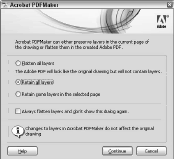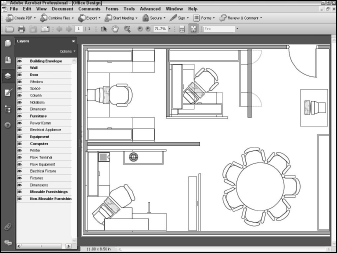Converting Visio and AutoCAD Documents To PDF
Engineers, technical professionals, and architects are among the many users of programs such as Microsoft Project, Microsoft Visio, and Autodesk AutoCAD. Each of these programs has an Acrobat PDFMaker to produce PDF documents.
In as much as you can either print PostScript or save as EPS from one or the other and distill the files in Acrobat Distiller, using PDFMaker is a much better choice. AutoCAD and Visio offer options for converting the AutoCAD and Visio layers to PDF layers.
It is critical to be certain that the Acrobat PDF Settings are enabled for converting layers with either program. Like all the other Microsoft programs, Microsoft Visio has an Acrobat PDFMaker set of tools and menu commands. When you open the Adobe PDF menu, you see a single addition for Visio appearing as Convert all Pages in Drawing.
Selecting this menu command converts all pages in the Visio file to PDF. Additionally you have a Change Conversion Settings option in Visio like the other Microsoft programs. Select Adobe PDF >> Change Conversion Settings and the Acrobat PDFMaker dialog box opens.
The settings unique to Visio are as follows:
- Include Visio custom properties as object data in the Adobe PDF. Programs such as Visio and AutoCAD support adding asset information on all the objects added to drawings. The metadata are hidden from view in the drawing itself. When the PDF is produced the object data are not visible in Acrobat in the document pane.
However, a special tool known as the Object Data tool in Acrobat and the free Adobe Reader lets you view, search, count, select, and copy metadata. In Acrobat you can also export the metadata as XML. Check this box if you want to use the Object Data tool in Acrobat to work with the metadata.
- Convert comments to Adobe PDF Comments. Comments added to a Visio file can be converted to Adobe PDF Comments.
- Always flatten layers in Adobe PDF. Microsoft Visio supports layers. If you want to retain layers in the resultant PDF, be certain to keep this check box unselected. You can keep the check box unselected as a default and when the need arises to flatten layers, you can handle layer flattening in Acrobat.
- Open Layers Pane when viewed in Acrobat. If layers are created in the PDF, checking this box sets the Initial View in Acrobat to view Layers panel and Page where the Layers panel is opened when the PDF is opened in Acrobat.
Notice that the default Conversion Settings in Figure 8.32 uses the Standard Adobe PDF setting. This setting is Acrobat 5–compatible. Acrobat 5–compatible PDFs do not support layers.
In earlier versions of Acrobat you had to edit the conversion settings in the Acrobat PDFMaker dialog box and be certain you selected Acrobat 6 or greater compatibility. Failure to do so flattened layers in the resultant PDF. In Acrobat 8, you don’t have to worry about changing your Adobe PDF Settings to Acrobat 6 or greater compatibility.
When you click the Convert to Adobe PDF tool in Visio or select Adobe PDF >> Convert to Adobe PDF, you are presented first with a dialog box asking you if you want to Include Custom Properties. Click Continue and you proceed to an advanced Acrobat PDFMaker dialog box.
Click the Retain all layers radio button and the file is created with the Visio layers converted to Adobe PDF layers. You may wonder whether Acrobat automatically changes the Acrobat Compatibility to 6.0 or above on the fly as the PDF is created. Miraculously, Acrobat actually creates an Acrobat 5–compatible file with layers intact.
Although Acrobat 5 compatibility does not support Adobe PDF layers, the layers are indeed retained in the Acrobat 5–compatible file. After converting a Visio document to PDF with layers, the file opens with the layers pane in view.
Working with Object Data
Engineering and scientific programs often enable you to describe objects in drawings that result in object data that can be added to the metadata in a PDF document. When using Acrobat PDFMaker you can view certain metadata in the resultant PDF file.
To view the data, open the Object Data tool from a context menu opened on the Acrobat Toolbar Well. Move to an object and click. The navigation pane opens to show the Model Tree. From the Options menu, you have a number of menu commands related to working with Object data.
Objects in Visio are assigned custom properties for associating costs and comments with each milestone in a project. These data elements are added to the individual objects’ metadata.
As shown in the Options menu you have a number of commands available for copying data, selecting items, zooming views, counting objects, selecting similar objects, and so forth. One command that can help you find assets in a drawing is the Search command.
Select Search from either a context menu opened on the drawing or from the Model Tree panel and the Search pane opens. Type the object you want to search for and click the Search button. This can be helpful for engineers and architects when analyzing drawings and determining costs, compliance with building codes, and so on.


